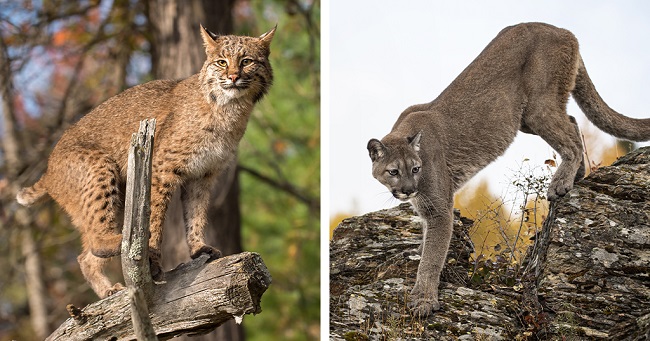The mountain lion and bobcat are two of North America’s most elusive and fascinating wild cats. Although they share a habitat and have similar traits, there are significant differences between them.
This article aims to provide a comprehensive comparison of these two amazing creatures, considering factors such as size, diet, habitat, behavior, and physical characteristics.

Physical Characteristics: Mountain Lion Vs Bobcat
Here is the physical characteristics and more information:
Read Also:
Mountain Lion
Also known as cougars, pumas, or panthers, mountain lions (Puma concolor) are one of the largest wild cats in North America. They possess a sleek body, with adults reaching up to 8 feet in length, including the tail, and weighing between 80-220 lbs.
Their coat color varies from tawny to grayish or reddish-brown. Mountain lions have a rounded head, and their most distinguishing feature is their long, heavy tail, which can reach up to one-third of their total length.
Bobcat
Bobcats (Lynx rufus), while smaller than mountain lions, are still sizable wild cats. They typically measure between 26-41 inches in length, excluding the tail, and weigh between 15-30 lbs.
Bobcats have a spotted coat that aids in camouflage and a distinctive short (“bobbed”) tail, which gives them their name. They also have tufted ears, similar to their lynx relatives.
Habitat: Mountain Lion Vs Bobcat
Both mountain lions and bobcats are adaptable and inhabit a wide range of environments.
Mountain Lion
Mountain lions have an extensive range, covering from the Canadian Yukon to the southern Andes of South America. They thrive in diverse habitats, including forests, swamps, grasslands, and even deserts.
Bobcat
Bobcats, native to North America, are found from southern Canada to central Mexico. They are versatile and can live in forests, semi-deserts, urban edges, and even swampland.
Diet and Hunting Techniques: Mountain Lion Vs Bobcat
Here is the diet and hunting techniques of mountain lion vs bobcat:
Mountain Lion
Mountain lions are apex predators and primarily feed on large ungulates like deer. However, they can also consume smaller animals like coyotes, porcupines, and raccoons. Mountain lions employ a stalk-and-ambush technique, often leaping onto their prey from behind.
Bobcat
Bobcats have a diverse diet, including rabbits, rodents, birds, and even small ungulates. They are solitary hunters, using stealth and ambush tactics similar to the mountain lion, although they typically target smaller prey due to their size.
Behavior: Mountain Lion Vs Bobcat
Behavioral difference between mountain lions vc bobcat:
Mountain Lion
Mountain lions are solitary creatures, with males having larger territories that often overlap with several females’ territories. They are crepuscular, meaning they’re most active during dawn and dusk.
Bobcat
Like mountain lions, bobcats are also solitary and maintain territorial boundaries marked with their scent. They can be active day or night but are primarily crepuscular.
Read Also:
Conclusion
While mountain lions and bobcats share several traits, including a solitary lifestyle, adaptable nature, and similar hunting techniques, they differ significantly in terms of size, diet preferences, and physical features.
Understanding these differences can enhance our appreciation of these amazing creatures and underscore the need for their conservation.
As these are wild animals, it is essential to remember that they should be admired from a distance. Human interactions should be minimized to ensure both our safety and their undisturbed existence in their natural habitats.
























